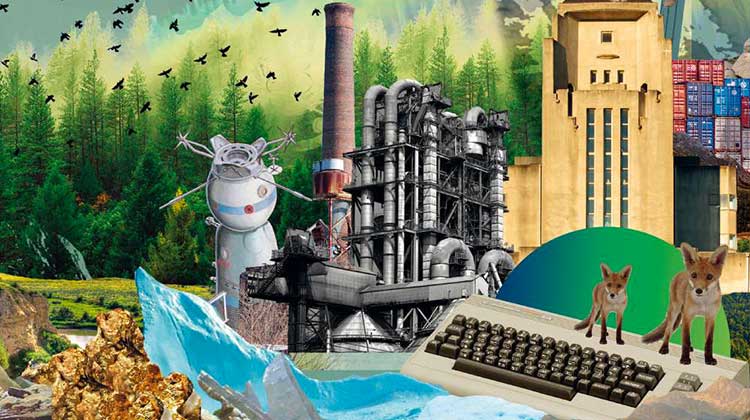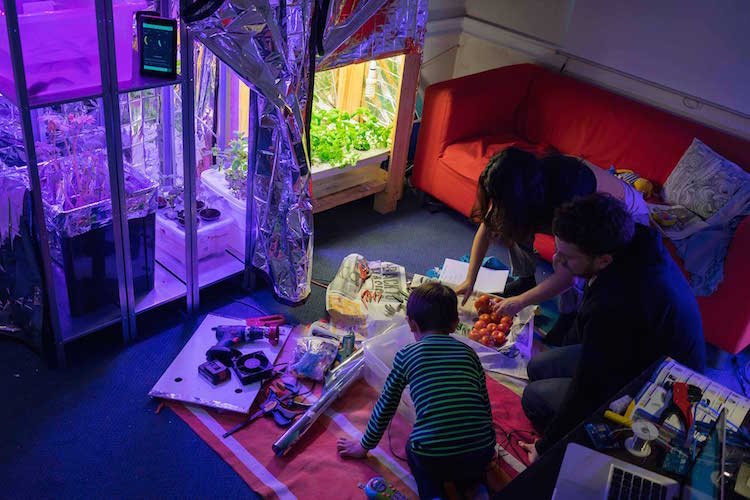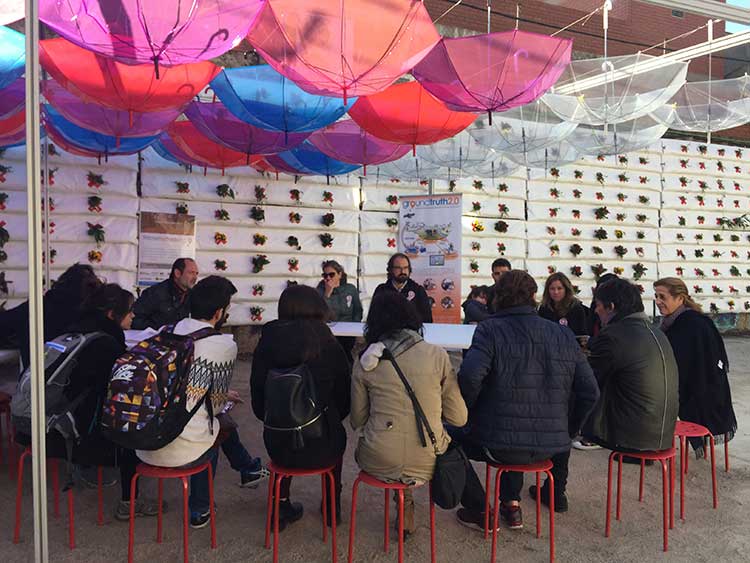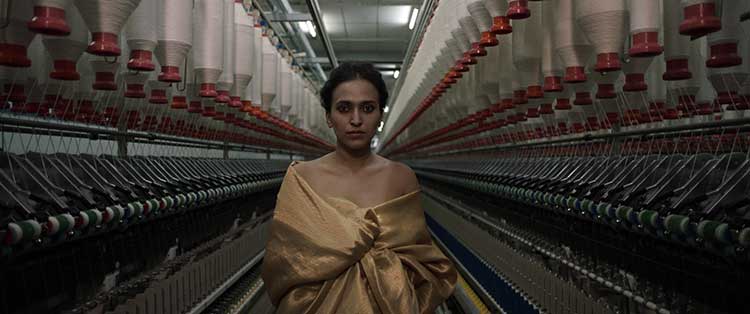“Think of Yourself as a Planet”
Published 24 April 2018 by Rob La Frenais
Last days to see the exhibition “After the End of the World” at the Center for Contemporary Culture of Barcelona, which speculates on climate change, the end of humans… and becoming jellyfish.
Barcelona, special report
Not many art exhibitions appear to be almost overseen in their curation by a famous philosopher and science-fiction writer. This is the case of After the End of the World, now showing at the Center for Contemporary Culture of Barcelona (CCCB) through May 1. Littered liberally around a number of immersive installations are random video clones of philosopher Timothy Morton, coiner of the term “Dark Ecology”, musing, as the exhibition’s “Minister of the Future”, on the endgame of post-Anthropocene humanity (once humankind has permanently messed up the Earth’s ecosystem).

After the End of the World (Després de la fi del món, in Catalan) is no ordinary art exhibition, but instead a series of speculative experiments and statements. Viewers are beckoned into the exhibition in “staged prologues” by science-fiction writer Kim Stanley Robinson: “Think of yourself as a planet. Fifty percent of the DNA inside your body is not human DNA. Consider what that implies. It means you are a complex ecosystem, like a forest or a marsh. You exist like jellyfish in the ocean: Earth washes in and out of you with every breath you take. So when you talk about your planet, you’re talking about your body. And remember: a fever can kill you.”
“The jellyfish are winning”
Speaking of jellyfish, world jellyfish expert Lisa Ann Gershwin (author of Stung! On Jellyfish Blooms and the Future of the Ocean) inspired the Win-Win installation by Berlin-based collective Rimini Protokoll with her statement: “We are in this crazy, unforeseen and incomprehensible situation where we are competing against jellyfish. And they are winning.” In this participatory theatre work, the (human) audience faces a huge tank of jellyfish. As the tank transforms into a mirror, the viewers are asked who has a better chance of survival on the planet: jellyfish or humans? The jellyfish win, of course. In a simple trick, the viewers are instructed to wave goodbye to each other, and also, ultimately, to the human race.
“Win-Win”, presentation of the installation by Rimini Protokoll in Barcelona:
The survival of humans in urban situations is highlighted in a simulated city apartment in Superflux’s Mitigation of Shock, where occupants in a future situation of mass food shortages are forced to manufacture their own food in home factories, using hydroponics and other techniques, as well as hunting urban foxes and collecting mealworms… Anab Jain, cofounder of Superflux with Jon Ardern, explains: “We wanted to hint at the shiny future that is being predicted by tech companies and corporations. The lived reality will be somewhere in the middle.”

The apartment contains some intriguing details, with bubbling fluorescent vats of “food” and an apparent radio broadcast of weather disasters worldwide, as well as various gadgets that are no longer relevant, like a fridge that tells you it’s run out of milk—but there’s no milk.
Curator José Luis Vicente, in his catalogue essay, points out that “all this has already happened in the age of the Anthropocene” (for example, the sea level rises every year by 4 millimeters from the melting of the poles and the expansion of water in the oceans due to increasing temperatures) and lists what must be done according to the Paris Agreement on climate change.
Battle between sand and sea levels
These rising sea levels are juxtaposed with the rising value of land in high-density living environments such as Singapore, where artist-sailor Charles Lim lives and works. In Sea State 9 – Proclamation he uses his native Singapore as an artwork in itself, focusing on the massive purchase and movements of sand in Singapore’s land reclamation projects. Singapore is the world’s largest purchaser of sand and pays the highest prices for it, to the extent that some countries now ban the sale of sand to the island nation. Lim finds it ironic that as this futuristic city-state expands in a battle for more space to build, sea levels are rising to again reclaim the land in the next 50 years. Accompanying a legal proclamation by the government is breathtaking drone video footage of large sea vessels “terraforming” land. On a screen inserted into the installation, the public is encouraged to bid for sand themselves on alibaba.com.
“Sea State 9 – Proclamation”, Charles Lim:
Futurologist Timothy Morton likens the human condition to waiting on a series of railway platforms: “There is not just the human platform anymore. There’s the biosphere’s railway platform. There’s the railway platform of the polar bear, the platform of the bacterial microbiome. There’s the platform of Earth’s magnetic shield, which protects lifeforms from solar rays. There’s the platform of this lizard crawling across my floor.”
Throughout the exhibition are avatars of Morton interspersing each artwork with his provocative thoughts on a loud soundtrack. While interesting, a criticism of this exhibition might be that these interpretative interventions are distracting from the more subtle artworks, such as Charles Lim’s. The exhibition design is distracting too, forcing the viewer to circulate in the manner of a science museum or theme park.

The artist-engineer Natalie Jeremijenko is trying to alter history and cure, in her own way, the fever referred to by Robinson in her Environmental Health Clinic at City Station, interfacing with local citizen-science initiatives. “Cities are where the most significant changes are taking place on a global scale,” says the artist. “And you, as a citizen, are responsible for this. The future of everything around you depends on your actions. You are definitely an agent of change. Are you not quite sure where to begin? We’ll give you the tools to do it.”
The omnipresent Jeremijenko has also animated the exhibition with a number of provocations, such as proclaiming herself the “Ex-Queen” of Catalonia during the period of the declaration of independence and starting a movement to close down the city’s two nuclear power stations.

The duo Unknown Fields Division (Kate Davies and Liam Young), known for research expeditions to various parts of the planet such as Chernobyl, Baikonur and other places significant in the Anthropocene, presents one of the more ambitious commissions with Unravelled, shot in Bangladesh. Documenting the production of fashion garments, factories, milling and a ship-breakers yard, the film shows a fashion model walking through them slowly, draped in a gold-threaded garment made there. Ironically, the way they got permission to film was by claiming they were doing a fashion shoot, which this video resembles.
Rising above a deserted world
Finally, there is a new presentation of Tomas Saraceno’s Aerocene, his long-term project to inhabit the atmosphere. This features a version of the film shot in White Sands desert in 2015. It’s an artistic project (curated by me) to launch the world’s first zero-carbon human solar balloon (which Makery covered here) at a restricted missile base (before the election of Donald Trump). The film also includes evocative Super-8 home-movie footage of Saraceno’s team undertaking unofficial private DIY “Aerocene Explorer” kite experiments at dawn in the empty desert, not far from the U.S.-Mexico border and the Trinity nuclear site—a unique place in the post-Anthropocene landscape of America’s cold war memories.
“After the End of the World”, showing through May 1 at the Center for Contemporary Culture of Barcelona (CCCB)
